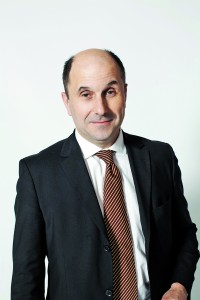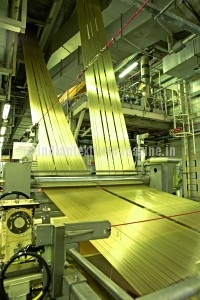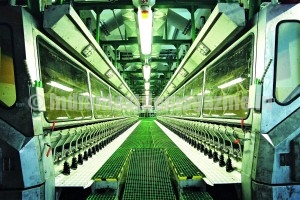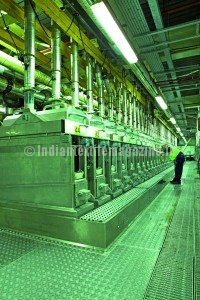
In spite of difficult market conditions in its core fiber business, Lenzing succeeded in achieving the second best business results in its history in the 2012 financial year. This can be attributed to new record fiber sales volume and the good performance of Lenzing’s specialty fibers Lenzing Modal and TENCEL.
Consolidated sales of the Lenzing Group were down slightly from the previous year, declining by 2.3 per cent to EUR 2.09 billion compared to EUR 2.14 billion in 2011. The underlying reason for stagnating sales was the significantly lower average fiber selling prices in contrast to the boom year 2011. However, this price development could be compensated by a strong rise in fiber sales volumes, which climbed by close to 14 per cent year-on-year, from 712,000 tons to 810,000 tons.
The core Segment Fibers accounted for 90.1 per cent of consolidated sales. The smaller Segment Plastics Products generated 7.6 per cent, the Segment Engineering 2.2 per cent and others accounted for 0.1 per cent (based on external sales).
Fibers
Lenzing’s Segment Fibers achieved a new sales record in 2012 against the backdrop of a very difficult business environment. The fiber market rewarded Lenzing for its high product and service quality as well as its close co-operation with and integration in the textile chain. The successful differentiation from standard products manufactured by Asian producers enabled Lenzing to operate all its fiber production facilities at full capacity against the backdrop of a market environment characterized by a high supply and weak prices. Inventories were at a low level at the end of the year.
Sales of the specialty fibers Lenzing Modal and TENCEL and a gratifyingly stable nonwovens business served as the basis for a weakening of the general downward movement in prices. These brands succeeded in maintaining their premium character in such a market environment in 2012, and continued to be sold at a price premium of 40-60 per cent compared to standard viscose fibers. Specialty fibers accounted for approximately 35 per cent of fiber sales in 2012.
However, the Lenzing Group was not immune to the overall market trend. Whereas average fiber selling prices still equalled EUR 2.03 per kilogram in the first quarter of 2012, prices fell to EUR 1.83 per kilogram in the fourth quarter of the year. In the course of the year, selling prices for Lenzing’s specialty fibers Lenzing Modal and TENCEL also had to be continually adjusted downwards in line with the new price situation arising as a result of the significant drop in cotton prices. This was in contrast to the high chemical prices prevailing throughout the year.
The price decline for dissolving wood pulp, the most important raw material used in fiber production, had a positive effect, but could not compensate for the decrease in fiber selling prices.

Further rise in fiber capacities
Important milestones were achieved in 2012 with respect to Lenzing’s ongoing fiber capacity expansion program. The main event was the commissioning of the fifth production line of the Indonesian subsidiary PT. South Pacific Viscose (SPV) at the end of October 2012. As a consequence of the additional nominal capacity of 80,000 tons of viscose fibers per year, total annual production capacity at SPV climbed to 320,000 tons. Thus, it exceeded the capacity of 252,000 tons per annum of the viscose plant at corporate headquarters in Lenzing (Upper Austria) for the first time, making SPV the largest single viscose fiber plant in the world.
In addition to the rapidly growing textile industry in Indonesia, one of the largest industrial sectors of the island State, the entire South-East Asian region is supplied with high-quality fibers for textile and nonwovens use from the Purwakarta plant.
Due to a very gratifying ramp-up curve, 80 per cent of the nominal capacity of the new production line could already be marketed two weeks after it was put into operation. Following the execution of the second expansion phase of the viscose fiber plant in Nanjing (China) initiated in 2011, the first half of 2012 was marked by the gradual ramping up of production at the site to reach the planned maximum volume. For the first time, nonwoven fibers were also manufactured by this facility. Additional investments of about $18 million for a debottlenecking program helped raise total capacities in Nanjing to 160,000 tons per annum.
At the Mobile, Alabama (USA) plant, the expansion drive designed to boost production capacity of TENCEL fibers from 40,000 tons to 50,000 tons per year was successfully concluded in the middle of the year. Production volumes were fully available starting in the fourth quarter of 2012 following a corresponding ramp-up phase.
There were further delays in constructing the planned viscose plant in India due to the request on the part of public authorities for additional expert appraisals. From today’s perspective, it is unrealistic to expect construction to begin before 2014.
Construction of new TENCEL plant
The comprehensive approval and licensing procedures carried out within the context of the environmental impact assessment for construction of the first TENCEL production plant at the Lenzing site were successfully concluded in the first half of 2012. Construction subsequently commenced on the new facility, which will feature an annual nominal capacity of 67,000 tons of TENCEL fibers, in June 2012. Construction is scheduled to take about 24 months, entailing total investments of approximately EUR 130 million (excl. infrastructure costs).
The new state-of-the-art TENCEL plant reflects next generation TENCEL technologies. The long-standing experience of the Lenzing Group in designing and operating TENCEL facilities is reflected in the first-time realization of a plant which boasts a single production line with a nominal capacity of 67,000 tons. Thanks to the new plant concept, Lenzing will achieve lower specific operating costs, a higher level of plant safety and availability and thus important competitive advantages.

Textile fiber innovations
One of the most important milestones achieved during the year under review with respect to product innovations in the field of textile fibers was the market launch of a new, spun-dyed modal fiber called Lenzing Modal COLOR. The advantage of the fiber is its particular eco-friendliness.
Dyeing is no longer necessary due to the fact that the color pigments are embedded directly in the fiber matrix. Steps have been taken to expand the range of colors offered for additional applications as a result of the positive customer feedback.
In 2012, a new application area was opened up for packing yarns made of spun-dyed Lenzing fibers, such as for fruit and vegetable nets. These nets are biodegradable, can be disposed of in the home compost and are of 100 per cent natural origin. They have already been used for packing onions and other vegetables by Ja! Natürlich, the organic brand of REWE International AG.
Lenzing also achieved initial success on the marketplace with additives to building materials. In this case, TENCEL powder is added to pasty plasters to enable better workability as well as improved drying behavior and reduced crack formation.
Furthermore, in 2012 Lenzing acquired the contract production of the specialty fibers smartcel and SeaCell for Smartfiber AG. These specialty fibers are primarily used in home textiles as well as in the wellness segment. The SeaCell fibers contain active substances from seaweed which nurture the skin and protect against free radicals. Smartcel sensitive is the first anti-bacterial, natural fiber available on the market to which the essential trace element zinc is added, thus enabling regenerative skin care and hygiene in textiles.

Nonwoven fibers
The global nonwoven fiber market in 2012 was characterized by declining cotton and polyester fiber prices, lower prices for pulp and increasingly tough competition due to new capacities along the downstream value chain.
In particular, new plant capacities in Europe for spun-bonded nonwoven production, for example for wipes, led to temporary surplus capacities. In contrast, development of the market in the US proved to be gratifyingly stable. The Asian nonwovens market also showed a clear upward trend during the year. Increasing prosperity, especially in China, led to a rise in nonwoven sales surpassing the comparable growth rates in the textile industry. This development also benefited the market for wipes, in which all emerging markets have a lot of catching up to do with respect to pro capital consumption.
The nonwovens business of the Lenzing Group in 2012 featured increasing sales volumes which climbed by about 15 per cent from the comparable level in the previous year, rising from approximately 206,000 tons to about 238,000 tons in 2012. This increase was the consequence of capacity expansion in China and Indonesia and the resulting higher sales volumes in North America.
First hydrophobic cellulose fiber
In terms of product innovations, the highlight of the year for the Business Unit Nonwoven Fibers was the market launch of the new fiber TENCEL Biosoft. For the first time, a hydrophobic*cellulose fiber was developed for completely new fields of application previously reserved to hydrophobic synthetic fibers such as polyester. Ideal applications for TENCEL Biosoft are hygiene products such as sanitary pads and panty liners as well as incontinence pads. The new fiber is also predestined for use in wipes, thanks to its softness and adaptable lotion management.
TENCEL microfibers also comprised an important area of research in 2012. These ultrafine fibers are required in order to be able to manufacture thin insulation layers made of paper. Another interesting area of application, amongst others, is in the production of electrical insulation paper for battery separators, for example for the purposes of e-mobility and electronics.
A special type of carbon is produced based on the carbonization of TENCEL powder. The applied technology is based on a combination of Lenzing’s TENCEL fibers and the technology provided by the business partner NanoCarbons LLC. After extensive research, Lenzing constructed a new pilot production facility to take the technology forward.
The jointly developed carbons should deliver optimal performance in the area of energy storage. It is believed that these new carbons will accelerate the development of the already rapid growth in uses of electrical storage devices such as double layer capacitors (also known as ultra capacitors or super capacitors). These high performance capacitors are being increasingly used in hybrid vehicles as well as with stop-start systems, uninterruptable power supplies and wind turbine blade orientation.
Outlook
The Lenzing Group registered good volume demand for its fiber products in the first weeks of 2013, both with respect to textile and nonwoven fibers. Lenzing’s fiber production capacities were operating at full capacity. However, prices continued to be at an unsatisfactory level.
Lenzing continues to assume that its fiber production capacities will be fully utilized for the rest of the year. This particularly applies to its new capacities in Indonesia (about 80,000 tons of viscose fibers per annum) and in the US (about 10,000 tons of TENCEL fibers per annum) which went on stream in 2012 and will contribute to further sales growth for an entire financial year for the first time in 2013.
In terms of costs, pulp prices are expected to remain largely unchanged, and chemical prices are not expected to ease up. One of Lenzing’s marketing priorities for its specialty fibers in the textile segment will be for emphasizing the technical advantages of processing TENCEL. A low price level for dissolving wood pulp is expected to prevail on the global market in 2013 and also on a medium-term basis as a consequence of the existing overcapacity.